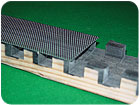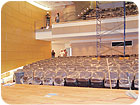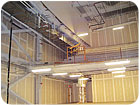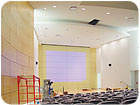
I can't believe how lucky I am. Last month, the U.S. fired up the most powerful, pulsed neutron source on the planet and I got to be a small part of the project. The Spallation Neutron Source covers 80 acres on the top of Chestnut Ridge at Oak Ridge National Laboratory, in Oak Ridge, Tenn. It cost $1.4 billion to build and is ten times more powerful than any other pulsed source, clearly putting the United States in the lead in neutron research.
OK, I hadn't heard of neutron research either-to be fair, there are only a total of 10,000 people in the world who are involved with the science. By shooting neutrons through materials like gypsum and paint, these scientists can see how the atoms and molecules arrange themselves and knowing this, they can determine what properties the material will have. They can then play around with the molecular arrangement of the gypsum and paint to improve those properties that are desirable.
Since the whole world is made of material of some sort or other, neutron experiments will benefit all industries. For example, atoms can be arranged to make plastic wires that conduct electricity. Ceramic particles may be engineered to fit within the molecular structure of a clearcoat to make scratch-resistant paint for cars. One scientist is even looking into stitching different molecules together to produce a paint-on display screen.
A thousand or so neutron wizards will use the SNS facility each year and the place in which they will confer, converse and otherwise hobnob with their fellow wizards is the CLO auditorium (my small part).

Detail of perforated metal reveal.
Doin' the Neutron Dance
The basic concept of how the SNS works is fairly simple.At the front end, hydrogen gas is given an electrical charge and shot into one end of a 1,000-foot-long tunnel called the Linac. Superconducting electrical coils, soaking in liquid helium at 456 degrees below zero, pull the charged hydrogen down the tunnel, accelerating it to 600 million miles an hour in 2 microseconds. (Zero to 600 in 2 microseconds is pretty good acceleration!)
At the end of the Linac, all of the electrons are ripped off the hydrogen atoms as they pass through a sheet of foil. The naked hydrogen atoms (they are just protons now) then circle endlessly around a 300 feet diameter Ring-shaped tunnel. As a bunch of protons pass by in the Ring, more are added from the Linac adding to their energy like a speed-of-light game of tetherball.
After making 1,060 trips around the Ring, the tetherball has grown to 150 trillion protons in size. It is then that it is let loose from the Ring to hurl directly toward the auditorium. Fortunately, the proton pulse enters the Target building instead, where it runs into 20 tons of liquid mercury.
The force of the impact is equivalent to that of a 200-pound block of steel traveling 50 miles per hour which causes the mercury to spray out neutrons, which are then guided to the various experiments to perform neutron research.
And all of this happens 60 times every second! See how simple it all is?
Those of you who want can get more information at thewww.sns.govWeb site.
Although the design of the SNS is infinitely more complex than that of the CLO auditorium, it is striking how similar the functions of some of their building components are.

Auditorium on final day of construction.
Shielding
The walls, floors and ceiling of the SNS Target building are designed to shield against neutron radiation. The tunnel leading into the target is lined with a 7 feet thick layer of steel and a 2 feet layer of concrete. The floor of the building is 5 feet thick. The walls, ceiling and floor around the mercury target is 12 million pounds of steel and 4 million pounds of concrete.Shielding was a big concern for the auditorium also. Not from neutron radiation, but from noise. Our team was assembled last Halloween, when the CLO building was complete, except that its auditorium was just a structural shell. Starting with this, our task was to design and build a state-of-the-art auditorium having superior speech intelligibility, which would also possess the musical acoustics to support the occasional quintet.
In this shell, sitting on a mezzanine, surrounding what would be the stage of the auditorium, were two large, noisy HVAC units. When designing a quiet space like an auditorium the first thing you want to do is make sure that all the loud noise sources are placed as far away as possible, but here we were surrounded by them.
HVAC noise is always difficult to shield against. Noise from the mechanical equipment has at least three ways to get where you don't want it. It travels directly through the walls. It travels through the ductwork. And, sometimes it travels half way down the ductwork and then breaks out into the space you're trying to shield. To protect the auditorium from HVAC noise, all three of these paths were addressed.
The solution for the CLO auditorium centered on creating a deadspace above the stage. The deadspace is basically a room with no doors or windows. Noise from the mechanical equipment that travels through the wall now finds itself not in the auditorium but in the deadspace. It can then attempt to pass through the wall separating the deadspace from the auditorium, but it has lost most of its energy by then. All HVAC ducts first pass through the deadspace before going into the auditorium. This catches most of the noise, which breaks out of the ducts. Any remaining breakout noise is blocked by a heavy lag-wrapping around the ductwork within the auditorium. Noise attempting to travel through the ductwork is absorbed by sound insulation, which lines the inside of each duct.

Auditorium shell before work began.
Amplification
The circular SNS Ring tunnel was designed with a size and shape that amplifies proton energy before directing it to the Target. The size and shape of the CLO auditorium ceiling and the space above the ceiling amplifies sound energy from the loudspeakers and then directs it to its target (audience).Excellent sound in an auditorium only occurs when the sound system and the room acoustics work hand in glove. When it is done right, it is difficult to say where the sound system ends and the room acoustics begin. In the CLO auditorium it is especially difficult to say where the sound system ends since the ceiling and the space above it act as a huge bass reflex speaker chamber. The amplification works so well, that only two, well-placed speakers are used to cover the entire auditorium.

View showing curved side wall.
Diffusion
In the SNS, components in the Target facility are designed to diffuse and disperse neutron energy in various directions. One of the most remarkable building components of the CLO auditorium is its sidewalls. They were designed and built specifically to diffuse and disperse sound energy in various directions.Typically the sidewalls of an auditorium will be covered with pyramid-shaped panels to diffuse sound. Flat walls are not used since they tend to act like mirrors, giving a reflection that sounds too harsh. Concave walls are never used since they tend to give focused reflections, which sound even worse.
Going against common sense, the sidewalls of the CLO auditorium are concave. They are made from wood panels to match a common interior design theme throughout the CLO building. But, instead of producing a harsh, focused reflection, they disperse sound evenly throughout the auditorium. The secret is in the design of the 2-inch wide metal reveals that separate the wood panels. Instead of the typical chromed metal reveal used throughout the rest of the building, the reveals in the auditorium walls were specially made on-site from 2x4s and perforated metal. Project Manager Curtis Sleener of The D.L.P. Group, Corpus Christi, explained how it was done.
"The 2x4s were routed-out to create air passages and then painted black so they wouldn't show. Perforated metal strips were then stapled over the top of the air passages. These reveal assemblies were attached to the wall framing and then the wood panels were applied to complete the wall."
Although it is hard to spot, the difference in acoustics is astounding. Acoustically, the perforated reveals make the concave wall act like a wall full of pyramidal diffusers.
Git Rhythm
The most fun task I do in any job is the final test to check out how well the acoustics turned out. After making sure the sound system meets its performance specifications and measuring the background noise, speech intelligibility and reverberation of the room, there is always an opportunity to sit and listen to music and speech in the space. For the CLO auditorium, the background noise is reduced by 40 decibels, the speech intelligibility measures in the "excellent" range and reverberation is optimal. Speech is clearly heard throughout the auditorium, even where there are no seats. The music sounds great. (Since it was Tennessee, it had to be Johnny Cash.)The dead space above the stage protects the auditorium from mechanical noise. The space above the ceiling acts like a large bass reflex speaker to amplify, smooth and distribute sound. Reflections from the sidewalls are diffused, making the room sound much bigger than it really is. Discrete, high frequency reflections from the corners of the balcony add a nice surround sound effect to the mix. It was hard to leave.
Even though the CLO Auditorium is not nearly as complicated to operate as the Spallation Neutron Source, it has presented another complicated problem for the Oak Ridge National Laboratory to solve; namely, "Who gets to use the auditorium first?" As word spreads, ORNL scientists are scrambling to book the auditorium for their conferences.
If you read this article, please circle number 335.


Report Abusive Comment